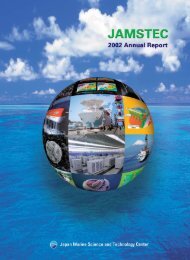2007 Annual Report - jamstec japan agency for marine-earth ...
2007 Annual Report - jamstec japan agency for marine-earth ...
2007 Annual Report - jamstec japan agency for marine-earth ...
Create successful ePaper yourself
Turn your PDF publications into a flip-book with our unique Google optimized e-Paper software.
September 2000 Mutsu Institute <strong>for</strong> Oceanography was inaugurated.<br />
April 2001 Seattle Office was opened.<br />
November 2001 Global Oceanographic Data Center (Nago-shi, Okinawa)<br />
was opened.<br />
April 2002 Earth Simulator recorded the world's highest computing per<strong>for</strong>mance.<br />
August 2002 Yokohama Institute <strong>for</strong> Earth Science was opened.<br />
April 2004 Independent Administrative Institution, Japan Agency <strong>for</strong><br />
Marine-Earth Science and Technology was inaugurated.<br />
July 2004 JAMSTEC 2005 <strong>Annual</strong> <strong>Report</strong> Japan Agency <strong>for</strong> Marine-<br />
Earth Science and Technology was reorganized as four research centers and<br />
three centers.<br />
February 2005 Survey on the <strong>earth</strong>quake off the coast of Indonesia's<br />
Sumatra Island was implemented.<br />
February 2005 URASHIMA set a new world record with a continuous<br />
cruise of 317 km.<br />
July 2005 Deep-sea drilling vessel Chikyu was completed.<br />
October 2005 Kochi Institute <strong>for</strong> Core Sample Research was established.<br />
April 2006 The JAMSTEC venture support system was launched.<br />
August 2006 Drilling tests were conducted with the Chikyu.<br />
March <strong>2007</strong> Shinkai 6500 completed its 1000th dive.<br />
March <strong>2007</strong> Seattle Office was consolidated with the Washington, D.C.<br />
Office.<br />
September <strong>2007</strong> Start of exploration by the Chikyu in the Nankai Trough<br />
Seismogenic Zone Experiment (NanTroSEIZE), as part of the Integrated<br />
Ocean Drilling Program (IODP).<br />
9. Introduction of offices and institutes<br />
(1) Yokosuka Headquarters<br />
JAMSTEC is engaged in research and development with<br />
the aim of elucidating global change phenomena, based on an<br />
understanding of the planet Earth as a single system centering<br />
on its oceans. As JAMSTEC's main research center, the<br />
Yokosuka Headquarters conducts advanced research and technical<br />
development on the global system, including research on<br />
prediction of global environmental change, research on the<br />
Earth's core dynamics, <strong>marine</strong> and extremobiosphere research,<br />
etc.<br />
As infrastructure supporting basic research in these areas,<br />
the Yokosuka Headquarters owns various large-scale research<br />
facilities, beginning with research ships, and a dedicated quay,<br />
and conducts operation and management work to ensure that<br />
these facilities are utilized efficiently.<br />
In addition, the Headquarters is also responsible <strong>for</strong> institute-wide<br />
management work such as personnel, accounting,<br />
administration, planning, compliance, and related matters.<br />
(2) Yokohama Institute <strong>for</strong> Earth Sciences<br />
The Yokohama Institute <strong>for</strong> Earth Sciences is a research<br />
center <strong>for</strong> the elucidation and prediction of global environmental<br />
change, research on the Earth's core dynamics, and similar<br />
topics, where simulations <strong>for</strong> these researches are developed<br />
with the full use of the Earth Simulator, the world's top-level<br />
supercomputer. The Earth Simulator is also used in research in<br />
advanced scientific fields, etc.<br />
In addition, as a data center of global environmental in<strong>for</strong>mation,<br />
the Yokohama Institute <strong>for</strong> Earth Sciences has established<br />
a system <strong>for</strong> making the latest research results widely<br />
available to the public where various data obtained from<br />
research and observation activities are compiled and managed<br />
as electronic in<strong>for</strong>mation.<br />
The Center <strong>for</strong> Deep Earth Exploration, which is responsible<br />
<strong>for</strong> the operation of the deep-sea drilling vessel Chikyu,<br />
which began full-scale exploration in September <strong>2007</strong>, also carries<br />
out its work at the Yokosuka Headquarters.<br />
(3) Mutsu Institute <strong>for</strong> Oceanography<br />
The Mutsu Institute <strong>for</strong> Oceanography (MIO, Photo 1)<br />
conducts time-series observational research in the North<br />
Pacific. It is the home port of the oceanographic research<br />
vessel Mirai, and provides support <strong>for</strong> observations by that<br />
vessel. The MIO also conducts various events and other<br />
activities aimed at increasing understanding of <strong>marine</strong> science<br />
and technology, centering on the Shimokita Peninsula<br />
region of Aomori Prefecture.<br />
1 Time-series observational research in the North Pacific<br />
The MIO is conducting time-series observation to capture<br />
environmental variations and changes in the ocean at<br />
Station K2(47˚N, 160˚E) in the subarctic northwestern<br />
Pacific Ocean. The “Mirai” made observational cruise<br />
MR07-05 was conducted in the autumn season in <strong>2007</strong>,<br />
when the nutrients used by phytoplankton are at their lowest<br />
level. In addition, a buoy array was deployed with the aim of<br />
clarifying the detailed variations in nutrients at around a<br />
depth of 35m, and the seasonal and interannual changes in<br />
the composition of settling particles.<br />
Observations carried out to date have revealed that the concentration<br />
of CO 2 on the surface layer in the subarctic gyre in<br />
the northwestern Pacific Ocean is increasing with time, and the<br />
composition of the particles from which organisms originate<br />
tends to change interannualy. Furthermore, knowledge about<br />
seasonal variations in nutrients in the northwestern Pacific, the<br />
relationship between phytoplankton and primary production,<br />
seasonal variations in primary productivity, POC flux and others<br />
was accumulated based on disequilibrium of Th-234.<br />
A compact drifting buoy in-situ automatic CO 2 measuring<br />
device (CO 2 sensor) was developed. This development is supported<br />
with the Marine Development and Earth Science and<br />
Technology Research Promotion Fund's "Japan Earth<br />
Observation System (EOS) Promotion Program (JEPP)".<br />
During FY <strong>2007</strong>, a device made during FY 2006 was tested in
















